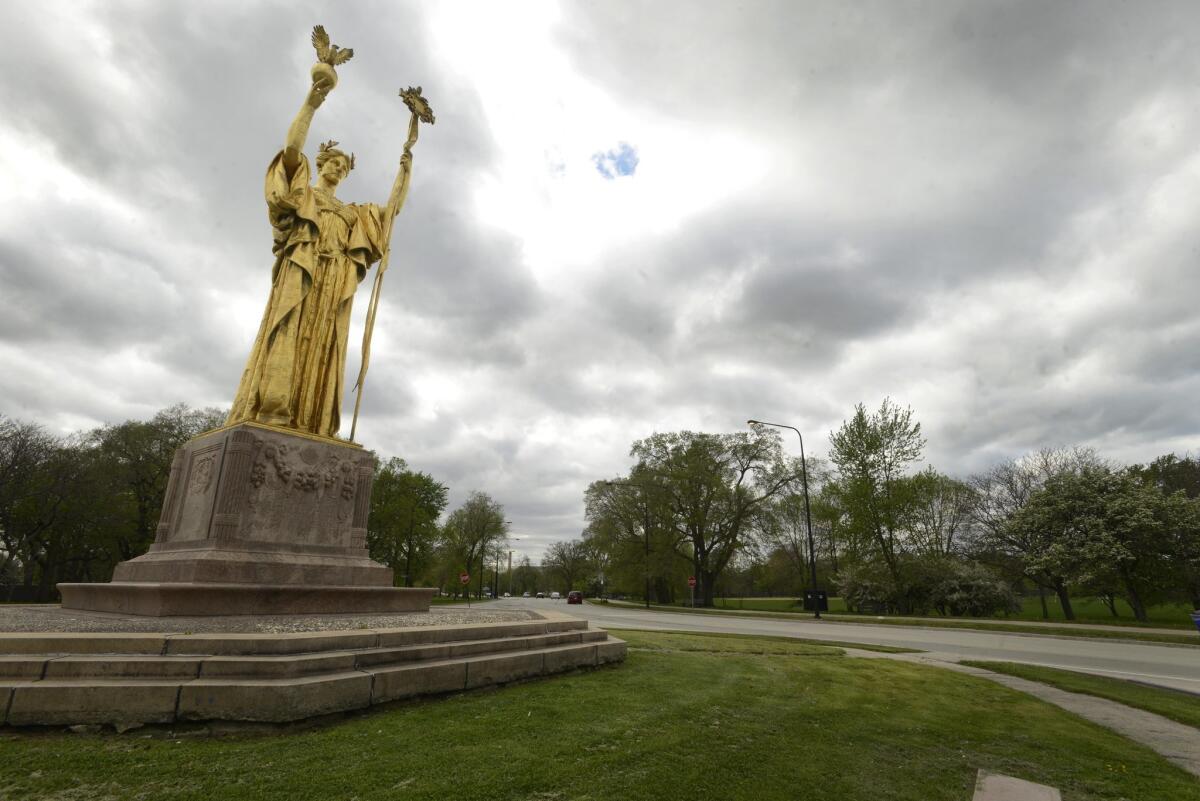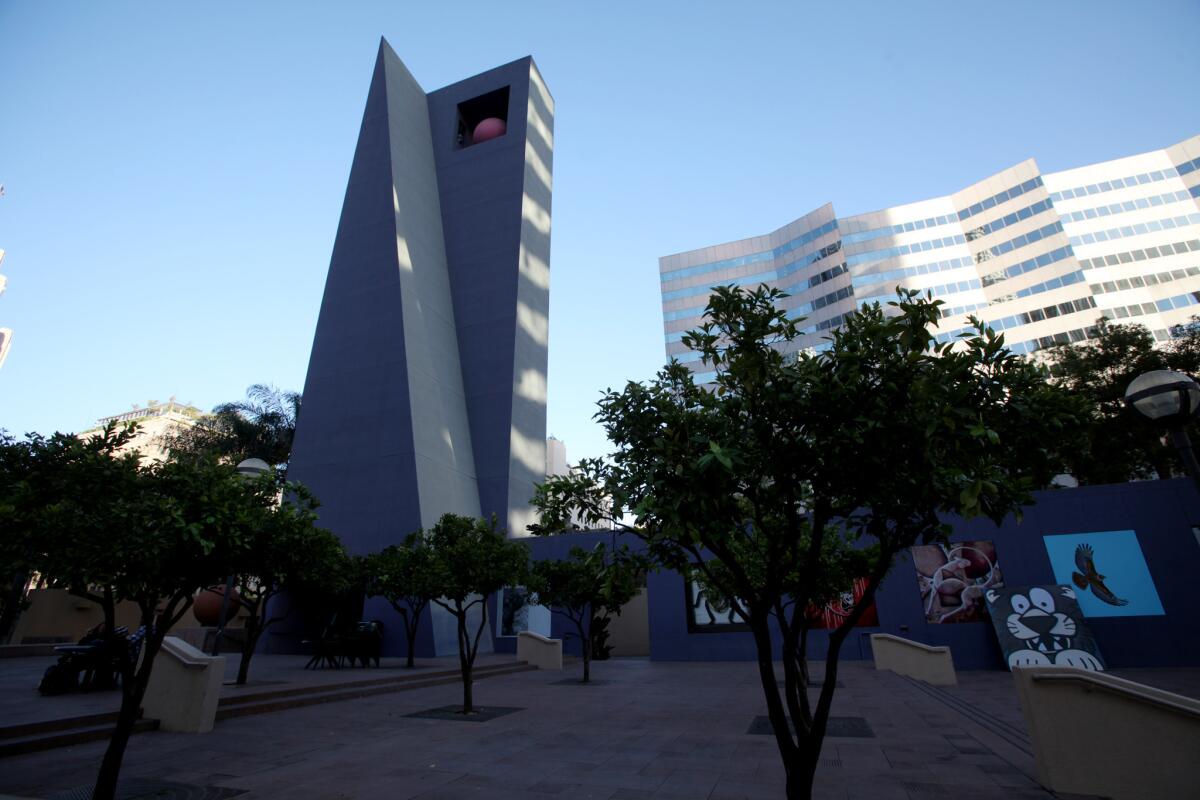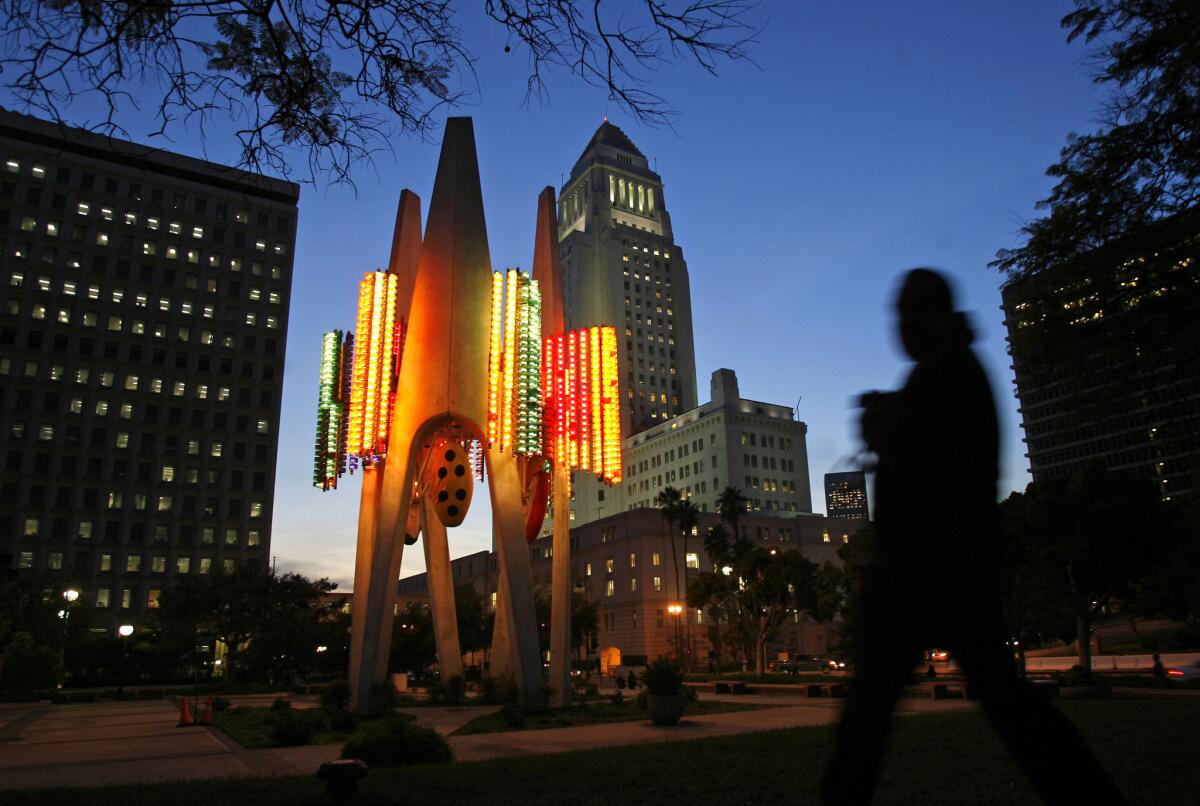Roundup: Obama chooses short list of library architects, U.S. releases art to Iran, Jeff Koons sued

Chicago’s Jackson Park is one of two sites being considered for the future home of President Obama’s presidential library. Seven architectural firms have been short-listed for the project.
- Share via
President Obama narrows the list of potential architects for his presidential library as Los Angeles winnows the list of architects to remake Pershing Square. Plus: New Orleans removes Confederate statues, critic Jerry Saltz considers the pluses and minuses of public-private space, and Joanne McNeil looks at the female-ness of digital assistants.
— Obama Foundation names finalists to design presidential library in Chicago. The list of seven firms consists of David Adjaye, Renzo Piano, Diller Scofidio + Renfro, Tod Williams Billie Tsien Architects, ShoP Architects, Snohetta and John Ronan Architects — the latter being the only Chicago studio on the list.

A view of Pershing Square, with architectural elements designed by Ricardo Legorreta in the early ‘90s. The square is in the early stages of another makeover.
— Planners for L.A.’s Pershing Square, in the meantime, have announced the four firms that will jockey to fix the nightmare that is Ricardo Legorreta’s 1990s redo of this storied civic space.
— New Orleans is removing four Confederate statues and is set to change the name of Lee Circle (after Confederate general Robert E. Lee) to Tivoli Circle.
— Congress recently announced that it would investigate the tax-exempt status of private art foundations. Kriston Capps of City Paper looks at what that could mean for a couple of Washington institutions — the Kreeger Museum and Glenstone — the latter of which can be very difficult to get into.
— Fourteen pieces of art purchased by Iran from U.S. dealers in 1978 — but impounded because of the 1979 Revolution — will finally be released to Tehran’s Museum of Contemporary Art. The works include architectural drawings by Michael Graves and Robert A.M. Stern.
— An acrimonious tiff between the Prado Museum and the Patrimonio Nacional in Spain over where some of the nation’s treasures should be housed, including Hieronymus Bosch’s 15th century canvas “The Garden of Earthly Delights,” has been settled. The works will remain at the Prado.
— Jeff Koons has been sued by a commercial photographer over the use of a gin ad in a 1986 painting.
— Some of the art world’s biggest collectors are also major GOP donors. Christian Viveros-Fauné roundups some of the big names and their collecting proclivities.
— Beverly Hills antiquities dealers Jonathan and Cari Markell are to serve prison time and probation respectively, for a tax evasion and antiquities smuggling scheme that resulted in raids on a number of Southern California museums.
— New York magazine critic Jerry Saltz explores that fraught intersection of public art and the private-public corporate space (such as the High Line): “Users of these new spaces are bullied for the duration of time spent here, kept busy, stimulated, programmed like robots and kindergartners. Here the mind dies, memory rapidly decays into some monotonous, impoverished tedium.”
— Speaking of which, Saltz, the man who burned his Museum of Modern Art press card this year, says that after shows devoted to artists such as Pablo Picasso and Joaquín Torres García, he is once again falling in love with the museum.

A view of artist Joseph Young’s ‘Triforium’ sculpture in 2006. A reactive piece thatwas first unveiled in 1975, there is now interest in updating some of its technology.
— On the future of the Triforium, the iconic 1975 Joseph Young sculpture in downtown L.A. that was supposed to shoot Morse code lasers into space that tapped out the phrase “Los Angeles.”
— Pete Brook’s epic takedown of Pantone’s Color of the Year — which this year is two colors: pink and blue.
— Plus, a must-read from Martin Filler on SANAA’s Grace Farms, a spiritual center for tony Connecticut types.
— And because too much goodness is never enough: Architecture critics Alexandra Lange and Mark Lamster give their annual architecture “awards” on Curbed. Categories include “The Dwell Award for Bourgeois Solutions to the Housing Crisis” and the “Mitt Romney Sensitivity Award.” Glad to see the word “tripas” on Curbed.
— Also, the best book covers of 2015 according to the New York Times.

A cross-border pedestrian bridge connects the international airport in Tijuana to San Diego (at right). The new access began operations this month.
— There is now an international cross-border bridge connecting the U.S. to Tijuana’s airport. Related: A rendering of a 1960 plan for a cross-border aerial tramway.
— The entire print run of the L.A. punk magazine “Slash” is now online. Related: Raymond Pettibon’s Black Flag concert flyers.
— Why are digital assistants such as Siri, Cortana and Julie all female? A thoughtful exploration of gender in technology by Joanne McNeil.
— And last but not least, you’re not a true classicist until you rock ancient Greek pottery nail art.
Find me on Twitter @cmonstah.
More to Read
The biggest entertainment stories
Get our big stories about Hollywood, film, television, music, arts, culture and more right in your inbox as soon as they publish.
You may occasionally receive promotional content from the Los Angeles Times.











